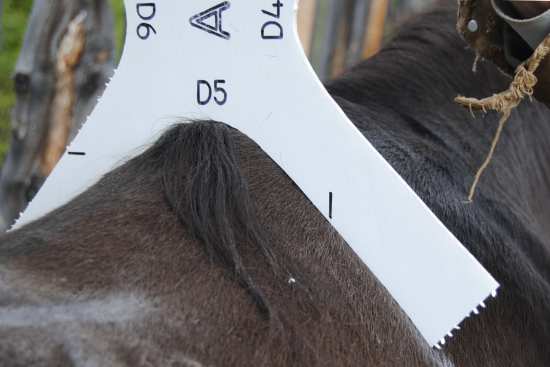How we use the Dennis Lane Equine Back Profiling System numbers
We are no longer building saddle trees, but we have two videos about how Western saddles fit horses available on our westernsaddlefit.com website.

We occasionally get people asking us how we use the Dennis Lane card system in building our trees, so I figured I would try to explain in a bit more detail than I have on our main website. We put up a section on how the cards are used on a horse to determine the shape of the horse so if you are unfamiliar with the system, there are lots of pictures there that explain it here on our site or you can go to Dennis's site and see his instructions.
What we don’t do
So when someone tells us their results, what do we do? Do we make bars the inverse shape of the cards? Do we have a whole jig system so we set it up to look just like that horse’s back and fit the tree to that as we build it? Do we have a bar pattern for every possible combination and permutation of bar specs? NO, NO, NO!!! None of the above!!
DL cards are just standardized back drawings
How does any tree maker use back drawings sent from a customer? We look at them and figure out what body type they represent and choose which of our specs would work well on that body type. And how do we know that? Well, we have done a lot of homework over the years. We have put a pile of trees of different spec combinations on a pile of horses of different shapes and sizes. We would start with “that looks like a 4 x 90 horse” or “I’ll try a 4 ¼ x 93 first”. We’d try on the size we thought would work well and see how we liked it. Then we would try other sizes of trees on to see if they fit better or worse. Over time, we, like any tree or saddle maker, got to have a pretty good eye for gauging what bar width and angle would be the best by looking at a horse. But to really know for sure, we had to try on a tree, because there is a lot of optical illusion when it comes to looking at horse’s backs.
More homework
So when we got the DL system, we had a whole new homework assignment to do. We went out with the cards and a number of trees of different specs. We carded a horse, kept track of the numbers, then threw up trees to figure out what specs were the best fit that horse. And we did this again, and again, and again. And guess what – they correlated!! The same DL numbers really did go with the same specs consistently!! So by the time we had done a bunch of horses, we could tell you that such and so DL numbers would work best with this and that combination of specs on our trees.
This is still an ongoing practice
Late last week we had a local guy bring us a couple of horses. We carded the horses, wrote down the numbers, walked into the shop to get trees with different fitting specs and tested them on the horses. Rod and I already had in mind what we wanted to use (and we agreed! :) ) but we wanted to try on the trees to confirm what we thought and to add to our data base. We could also show the owner what we liked or didn’t like about the fit of the different specs, and talk about the specs we would use to make a “middle of the road” tree that would work on both his horses, with different padding, even though one was larger than the other. But now we could really compare how much larger. Rather than just knowing “that one has wider withers”, we could say “there is a two card size difference between these horses”. We have learned that by the time you get, say, a four card size difference, you would have problems fitting that range of horses with one tree. For these two, they are close enough it won’t be a problem. We know that because we have seen the trees on the horses, and it confirms again what we have learned before. So now when we get a customer sending us specs from horses that fall into these sizes asking, "Can I use the same tree with this range?" we are even more confident telling them that they can.
So – no fancy stuff
Just plain background work to know what body shape the different cards represent, and knowing what specs we would use to fit that type. It is just a whole pile easier to get an e-mail (with pictures, as described on our website) with the DL numbers than to wait for back drawings sent through the mail, wondering if the customer took them right, if the wire changed shape between horse and paper (it happens), and then setting trees up over the drawings and looking down them to see what would probably fit the best. Now that we have the correlations pretty set (for all our common fits, anyway), a customer can give us the numbers and we can tell them what specs we will use. And we have had really good success using the system.
So if you want to learn more...
Here is a video of how the system works to measure horses.
